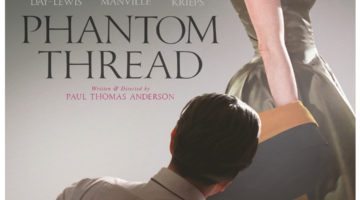 Some duos are so perfect, so natural, so necessary, that there’s an almost magnetic force that pulls them together. Jordan and Pippen, Batman and Robin, Thelma and Louise, Manafort and Putin—the list goes on and on.
Some duos are so perfect, so natural, so necessary, that there’s an almost magnetic force that pulls them together. Jordan and Pippen, Batman and Robin, Thelma and Louise, Manafort and Putin—the list goes on and on.
10 years ago, we were graced with one of the great pairings in movie history. 2007’s “There Will Be Blood” matched director Paul Thomas Anderson with actor Daniel Day-Lewis. The movie, propelled by oil, greed, and blasphemy, netted Day-Lewis the second of his record three Best Actor Oscars and Anderson a Best Director nomination. In the decade since, the two have combined to make just three movies, respectively. Last week, however, we were granted our first glimpse of the long-awaited follow-up, “Phantom Thread.”
From what can be gleaned from the trailer, Day-Lewis plays fashion designer Reynolds Woodcock, one of the more celebrated dressmakers in 1950’s London, who has love suddenly interjected into an otherwise solitary life. Day-Lewis, whose range knows no boundaries, appears 180 degrees opposite from his Daniel Plainview character, a sociopathic profiteer, from “There Will Be Blood.” The dressmaker we see in Anderson’s new movie is reserved, humble and understated.
But what is it that makes these two such a good match? Paul Thomas Anderson’s most beloved movies (“Boogie Nights,” “Magnolia,” “Punch-Drunk Love,” “There Will Be Blood”) feature characters wrought with emotional tension that finally boils over in spectacular fashion. For instance, “Boogie Nights” provides a mosaic of unforgettable characters, all with their own separate arcs like Mark Wahlberg, whose cocaine addiction and sense of entitlement blow up in his face. Adam Sandler, in a perfectly-tailored performance in “Punch-Drunk Love,” explodes in nearly-hilarious but ultimately uncomfortable ways, like when he shatters a sliding glass door in the middle of a family party or dismantles the interior of a restaurant bathroom in the middle of a quiet date.
These scenes serve as the lifeblood of Paul Thomas Anderson’s movies. As much as the dynamic camera work and the superb scores and soundtracks dress them up, their core is the human performances conjured up, typically from his lead actors. Day-Lewis is particularly adept at these roles. Beginning with his first Oscar-winning performance as Christy Brown, an Irish artist afflicted with cerebral palsy, Day-Lewis knows exactly how to show his character springing leaks. Whether it’s Brown banging his head on a table in frustration, Plainview using a bowling pin as a weapon or Abraham Lincoln pounding his fist and calling for unity, his characters have always had a believable and three-dimensional arc that typically culminates explosively.
Perhaps Anderson’s last two efforts, “The Master” and “Inherent Vice,” have alienated audiences because he’s gotten away from those types of characters. Both movies have featured protagonists played by Joaquin Phoenix, a talented actor but left with parts that failed to resonate or relate. The return of Day-Lewis, in what will reportedly be his final acting role, brings along with it a certain prestige that no other actor working today could match. Even in his more reeled-in performances, Day-Lewis spends most of his screen time building up to the inevitable boiling point, which nearly always comes (and if you don’t believe me, search Dan-Yell Day-Lewis on YouTube).
So while much of Hollywood still lives off of the dreamiest of director-actor pairings like Scorsese and DiCaprio, Villeneuve and Gosling, and even Spielberg and Hanks, there’s just one more chance to see perhaps the duo most uniquely suited for one another. “Phantom Thread” opens in limited release Christmas Day and wide two weeks later.












